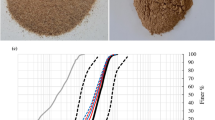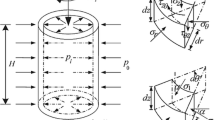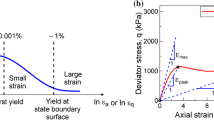The paper presents the results of an experimental study of strength anisotropy in sandy samples with “anisotropic fabric” induced by compaction loading. A direct shear apparatus used is introduced. To prepare anisotropic samples, a specimen compacted to optimum water content was frozen. Six samples, each with a different shearing angle were then bored from the specimen. After boring, these samples were placed in a shear box and heated to melting. The maximum shear strength was observed for a sample with shearing angle +15°.
Similar content being viewed by others
References
A. Casagrande, A. and N. Carrillo, “Shear Failure of Anisotropic Materials,” Proceedings of the Boston Society of Civil Engineers, 31, 74-87 (1944).
R. Brewer, Fabric and Mineral Analysis of Soils, John Wiley and Sons, Inc., New York (1964).
M. Oda and H. Nakayama, “Introduction of Inherent Anisotropy of Soils in the Yield Function,” Micromechanics of Granular Materials, 81-90 (1988).
F. Tavenas and S. Leroueil, “Effects of Stress and Time on Yielding of Clays,” Proc. 9th ICSMFE, 1, 319-326 (1977).
J. Graham, M. L. Noonan, and K. V. Lew, “Yield states and stress strain relationships in a natural plastic clay,” Can. Geotech. J., 20(3), 502-516 (1983).
JGS0561, Direct Shear Test Method, Japanese Geotechnical Society Standard [in Japanese], Japanese Geotechnical Society (1979).
J. M. Duncan and H. B. Seed, “Anisotropy and Stress Reorientation in Clay,” JSMFD, 92(SM5), 21-50 (1966).
R. J. Mitchell, “Some Deviation from Isotropy in a Lightly Overconsolidated Clay,” Geotechnique, 22(3), 459-467 (1972).
A. S. Saada and G. F. Bianchini, “Strength of One-Dimensionally Consolidated Clay,” J. Geotech. Eng., 101(11), 1151-1164 (1975).
A. S. Balasubramaniam, “Some Factors Influencing the Stress-Strain Behavior of Clays,” Ph.D. thesis, University of Cambridge, UK (1969).
C. C. Ladd, “Stress-Strain Behavior of Anisotropically Consolidated Clays During Undrained Shear,” Proc. 6th ICSMFE, 1, 282-286 (1965).
A. S. Stipho, “Theoretical and Experimental Investigation of the Behavior of Anisotropically Consolidated Kaolin,” Ph.D. thesis, University College, Cardiff, UK (1978).
A. W. Bishop, “The strength of soils as engineering materials,” Geotechnique, 16(2), 89-130 (1966).
L. D. Wesley, “Influence of Stress Path and Anisotropy on the Behavior of Soft Alluvial Clay,” Ph.D. thesis, University of London, UK (1975).
L. Bjerrum, “Problems of soil mechanics and construction on soft clays and structurally unstable soils,” Proc. 8th ICSMFE, 3, 109-159 (1973).
C. C. Ladd, R. Foott, K. Ishihara, F. Schlosser, and H.G. Poulos, “Stress-deformation and strength characteristics,” Proc. 9th ICSMFE, 1, 421-494 (1977).
M. Mikasa, N. Takada, and A. Ohshima, “Anisotropy of undrained strength of one-dimensionally consolidated clay and natural deposits,” JSSMFE, 32(11), 25-30 (1984).
M. Mikasa, N. Takada, and A. Oshima, “In situ strength anisotropy of clay by direct shear test,” Proc. 8th ARC, 1, 61-64 (1987).
M. Mikasa, “Test apparatus and test procedures of Triaxial and direct shear testing,” Proc.10th Symposium on Soil Testing, JSSMFE, 117-123 (1965).
S. Nishimura, N. A. Ming, and R. I. Jardine, “Shear strength anisotropy of natural London Clay,” Geotechnique, 57(1), 49-62 (2007).
H. Hanzawa, T. Matsuno, and K. Tsuji, “Undrained strength and stability analysis of soft Iraqi clays,” Soils and Found., 19(2), 1-14 (1979).
T. Shogaki and N. Kumagai, “A slope stability analysis considering undrained strength anisotropy of natural clay deposit,” Soils and Found., 48(6), 805-819 (2008).
K. Weindieck, “Zur Struktur Koniger Medien,” Bautechnik, 6, 196-199 (1967).
A. K. Parkin and C. M. Gerrad, “Discussion on deformation of sand in shear,” JSMFD, ASCE, 94(SM1), 336-340 (1968).
J. R. F. Arthur and B. K. Menzies, “Inherent anisotropy in a sand,” Geotechnique, 22(1), 115-128 (1972).
M. Oda, “Initial fabrics and their relations to mechanical properties of granular materials,” Soils Found., 12(1), 17-36 (1972a).
M. Oda, “Deformation mechanism of sand in triaxial compression tests,” Soils Found., 12(4), 45-63 (1972).
M. Oda, “The mechanism of fabric changes during compressional deformation of sand,” Soils Found., 12(2), 1-18 (1972).
A. A. EL-Sohby and K. Z. Andrawes, “Experimental examination of sand anisotropy,” Proc. 8th ICSMFE, 1, 103-109 (1973).
J. R. F. Arthur and A. B. Phillips, “Homogeneous and layered sand in triaxial compression,” Geotechnique, 25(4), 799-815 (1975).
M. Oda, I. Koishikawa, and T. Higuchi, (1978), “Experimental study of anisotropic shear strength of sand by plane strain test,” Soils Found., 18(1), 25-38 (1978)
Y. Yamada and K. Ishihara, “Anisotropic deformation characteristics of sand under three-dimensional stress conditions,” Soils Found., 19(2), 79-94 (1979).
Y. Yamada and K. Ishihara, “Undrained deformation characteristics of loose sand under three-dimensional stress conditions,” Soils Found., 21(1), 97-107 (1981).
M. Oda, “Anisotropic strength of cohesionless sands,” J. Geotech. Eng. Div., ASCE, 107(9), 1219-1231 (1981).
M. Oda and I. Koishikawa. “Anisotropic fabric in sands,” Proc. 9th ICSMFE, 1, 235-238 (1977).
P. V. Lade and A. V. Abelev, “Characterization of Cross-Anisotropic Soil Deposits from Isotropic compression tests,” Soils Found., 45(5), 89-102 (2005).
H. Matsuoka and H. Ishizaki, “Deformation and strength of anisotropic soil.” Proc. Int. Conf. Soil Mech. Found. Eng. 10, Stockholm, 1, 699-702 (1981).
P. I. Lewin, Y. Yamada, and K. Ishihara, “Correlated drained and undrained 3D tests on loose sand,” IUTAM Conf. Deformation and Failure of Granular Materials, Delft, Balkema, Rotterdam, 419-429 (1982).
H. Ochiai and P. V. Lade, “Three-dimensional behavior of sand with anisotropic fabric.” J. Geotech. Eng., ASCE, 109(10), 1313-1328 (1983).
R. K. S. Wong and J. R. F. Arthur, “Induced and inherent anisotropy in sand,” Geotechnique, 35(4), 471-481 (1985).
Y. Nakata, M. Hyodo, H. Murata, and N. Yasufuku, “Flow deformation of sands subjected to principal stress rotation,” Soils Found., 38(2), 115-128 (1998).
M. Yoshimine, K. Ishihara, and W. Vargas, “Effects of principal stress direction and intermediate principal stress on undrained shear behavior of sand,” Soils Found., 38(3), 179-188 (1998).
E. Masad and B. Muhunthan, “Three-dimensional characterization and simulation of anisotropic soil fabric,” J. Geotech. Geoenv. Eng., 126(3), 199-207 (2000).
A. V. Abelev and P. V. Lade, “Effects of cross anisotropy on three-dimensional behavior of sand. I: Stress - strain behavior and shear banding.” J. Eng. Mech., 129(2), 160-166 (2002).
P. V. Lade and A. V. Abelev, “Effects of cross anisotropy on three-dimensional behavior of sand. II: Volume change behavior and failure.” J. Eng. Mech., ASCE, 129(2), 167-174 (2002).
K. Tanimoto, “Preliminary study of the correlation of SPT N-values with the velocity of shear waves in sands,” Construction Engineering Research Institute Foundation, Report 16, 103-111 (1974).
X. Zeng and B. Ni, “Stress-induced Anisotropic G max of sands and its measurement,” J. Geotech. Geoenviron. Eng., 125 (9), 741-749 (1999) .
R. Kuwano, “The stiffness and yield”ing anisotropy of sand,” PhD. thesis, Imperial College of Science, University of London, United Kingdom (1999).
N. Takada, “Mikasa's Direct Shear apparatus, Test Procedures and Results,” Geotech. Testing J., 16 (3), 314-322 (1993).
H. Ishikawa, Y. Liu, A. Mochizuki, S. Okada, and S. Sreng, “Development of a direct shear apparatus with a double-jacks system and the effect of the double-jacks system,” Japan. Geotech. J., 4(1), 11-19 (2009).
A. Zh. Zhussupbekov, S. B. Yenkebaev, R. Ye. Lukpanov, and A. S. Tulebekova, “Analysis of the settlement of pile foundations under soil conditions of Astana,” Soil Mech. Found. Eng., 49(3), 99-104 (2012).
Author information
Authors and Affiliations
Corresponding author
Additional information
Translated from Osnovaniya, Fundamenty i Mekhanika Gruntov, No. 6, p. 25, November-December, 2020.
Rights and permissions
About this article
Cite this article
Mochizuki, A., Zhussupbekov, A., Fujisawa, J. et al. Strength Anisotropy of Compacted Sandy Material. Soil Mech Found Eng 57, 480–490 (2021). https://doi.org/10.1007/s11204-021-09696-1
Published:
Issue Date:
DOI: https://doi.org/10.1007/s11204-021-09696-1




